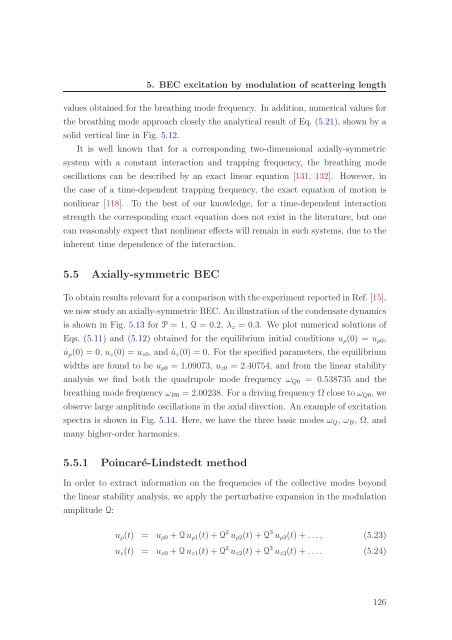PhD thesis in English
PhD thesis in English
PhD thesis in English
You also want an ePaper? Increase the reach of your titles
YUMPU automatically turns print PDFs into web optimized ePapers that Google loves.
5. BEC excitation by modulation of scatter<strong>in</strong>g lengthvalues obta<strong>in</strong>ed for the breath<strong>in</strong>g mode frequency. In addition, numerical values forthe breath<strong>in</strong>g mode approach closely the analytical result of Eq. (5.21), shown by asolid vertical l<strong>in</strong>e <strong>in</strong> Fig. 5.12.It is well known that for a correspond<strong>in</strong>g two-dimensional axially-symmetricsystem with a constant <strong>in</strong>teraction and trapp<strong>in</strong>g frequency, the breath<strong>in</strong>g modeoscillations can be described by an exact l<strong>in</strong>ear equation [131, 132]. However, <strong>in</strong>the case of a time-dependent trapp<strong>in</strong>g frequency, the exact equation of motion isnonl<strong>in</strong>ear [118]. To the best of our knowledge, for a time-dependent <strong>in</strong>teractionstrength the correspond<strong>in</strong>g exact equation does not exist <strong>in</strong> the literature, but onecan reasonably expect that nonl<strong>in</strong>ear effects will rema<strong>in</strong> <strong>in</strong> such systems, due to the<strong>in</strong>herent time dependence of the <strong>in</strong>teraction.5.5 Axially-symmetric BECTo obta<strong>in</strong> results relevant for a comparison with the experiment reported <strong>in</strong> Ref. [15],we now study an axially-symmetric BEC. An illustration of the condensate dynamicsis shown <strong>in</strong> Fig. 5.13 for P = 1, Q = 0.2, λ z = 0.3. We plot numerical solutions ofEqs. (5.11) and (5.12) obta<strong>in</strong>ed for the equilibrium <strong>in</strong>itial conditions u ρ (0) = u ρ0 ,˙u ρ (0) = 0, u z (0) = u z0 , and ˙u z (0) = 0. For the specified parameters, the equilibriumwidths are found to be u ρ0 = 1.09073, u z0 = 2.40754, and from the l<strong>in</strong>ear stabilityanalysis we f<strong>in</strong>d both the quadrupole mode frequency ω Q0 = 0.538735 and thebreath<strong>in</strong>g mode frequency ω B0 = 2.00238. For a driv<strong>in</strong>g frequency Ω close to ω Q0 , weobserve large amplitude oscillations <strong>in</strong> the axial direction. An example of excitationspectra is shown <strong>in</strong> Fig. 5.14. Here, we have the three basic modes ω Q , ω B , Ω, andmany higher-order harmonics.5.5.1 Po<strong>in</strong>caré-L<strong>in</strong>dstedt methodIn order to extract <strong>in</strong>formation on the frequencies of the collective modes beyondthe l<strong>in</strong>ear stability analysis, we apply the perturbative expansion <strong>in</strong> the modulationamplitude Q:u ρ (t) = u ρ0 + Q u ρ1 (t) + Q 2 u ρ2 (t) + Q 3 u ρ3 (t) + . . ., (5.23)u z (t) = u z0 + Q u z1 (t) + Q 2 u z2 (t) + Q 3 u z3 (t) + . . .. (5.24)126
















